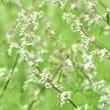Background
- Sweet annie (Artemisia annua) is also known as Chinese wormwood or sweet wormwood. Although it is in the same genus as both wormwood (absinthe, Artemisia absinthium) and mugwort (Artemisia vulgaris), each of these herbs has different uses and should not be confused.
- For more than 1,500 years, sweet annie tea was used in traditional Chinese medicine (TCM) to treat fevers, although the herb fell out of favor for a few centuries. In 1970, a TCM handbook from the 5 Century was discovered and stimulated interest in sweet annie. Although originally used to treat fevers, sweet annie was not used specifically for malaria.
- Sweet annie's main active constituent is artemisinin, which has shown rapid antimalarial activity in humans, especially when used as an adjuvant with standard antimalarial drugs. Considered a weed by some, the plant can be grown in many climates and a simple and effective preparation of Artemisia annua could be a much-needed inexpensive and convenient weapon against malaria. In addition to its promise in treating malaria, preliminary evidence indicates that sweet annie may have potential as an anticancer agent and an antiviral.
References
- Berger TG, Dieckmann D, Efferth T, et al. Artesunate in the treatment of metastatic uveal melanoma--first experiences. Oncol Rep. 2005;14(6):1599-1603.
View Abstract - Bertea CM, Freije JR, van der Woude H, et al. Identification of intermediates and enzymes involved in the early steps of artemisinin biosynthesis in Artemisia annua. Planta Med 2005;71(1):40-47.
View Abstract - Chen HH, Zhou HJ, Wu GD, et al. Inhibitory effects of artesunate on angiogenesis and on expressions of vascular endothelial growth factor and VEGF receptor KDR/flk-1. Pharmacology 2004;71(1):1-9.
View Abstract - Efferth T. Molecular pharmacology and pharmacogenomics of artemisinin and its derivatives in cancer cells. Curr Drug Targets. 2006;7(4):407-421.
View Abstract - Haynes RK. From artemisinin to new artemisinin antimalarials: biosynthesis, extraction, old and new derivatives, stereochemistry and medicinal chemistry requirements. Curr Top Med Chem 2006;6(5):509-537.
View Abstract - Heide L. Artemisinin in traditional tea preparations of Artemisia annua. Trans R.Soc Trop.Med Hyg 2006;100(8):802.
View Abstract - Hsu E. The history of qing hao in the Chinese materia medica. Trans R.Soc Trop.Med Hyg 2006;100(6):505-508.
View Abstract - Lommen WJ, Schenk E, Bouwmeester HJ, et al. Trichome dynamics and artemisinin accumulation during development and senescence of Artemisia annua leaves. Planta Med 2006;72(4):336-345.
View Abstract - Mueller MS, Runyambo N, Wagner I, et al. Randomized controlled trial of a traditional preparation of Artemisia annua L. (Annual Wormwood) in the treatment of malaria. Trans.R.Soc.Trop.Med Hyg. 2004;98(5):318-321.
View Abstract - Rath K, Taxis K, Walz G, et al. Pharmacokinetic study of artemisinin after oral intake of a traditional preparation of Artemisia annua L. (annual wormwood). Am J Trop.Med Hyg. 2004;70(2):128-132.
View Abstract - Romero MR, Serrano MA, Vallejo M, et al. Antiviral effect of artemisinin from Artemisia annua against a model member of the Flaviviridae family, the bovine viral diarrhoea virus (BVDV). Planta Med 2006;72(13):1169-1174.
View Abstract - Singh NP, Lai HC. Synergistic cytotoxicity of artemisinin and sodium butyrate on human cancer cells. Anticancer Res 2005;25(6B):4325-4331.
View Abstract - Van der Meersch H. [Review of the use of artemisinin and its derivatives in the treatment of malaria]. J Pharm Belg. 2005;60(1):23-29.
View Abstract - Wu GD, Zhou HJ, Wu XH. Apoptosis of human umbilical vein endothelial cells induced by artesunate. Vascul.Pharmacol. 2004;41(6):205-212.
View Abstract - Yance DR Jr., Sagar SM. Targeting angiogenesis with integrative cancer therapies. Integr.Cancer Ther. 2006;5(1):9-29.
View Abstract







